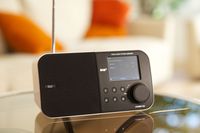Germany - Services on Air - History
27.08.2015
In total, there are more than 150 radio stations which can be received digitally across the 16 German Bundeslaender: 11 national programmes, over 60 public stations distributed by ARD members, and around 80 commercial stations (regional or local). The majority of radio programmes are equipped with accompanying data services including at least Dynamic Label Segment or DL+ and Slideshow. In particular, all public ARD radio brands are broadcast with additional services accompanying the live audio service: Now-next information (DLS/DL+), Programme previews (EPG), Weather and traffic charts, news headlines, track/title-cover (slideshow/categorised slideshow), Future mobility service (TPEG), and Hybrid EPGs and Slideshows (RadioVIS and RadioEPG).
National programme offers
Nine commercial radio services as well as three radio programmes from the national public broadcaster Deutschlandradio are broadcast on the national multiplex, which is operated by Media Broadcast. Pop, rock, electronic, and classical music are available as well as spoken word content, debates and Christian, culture radio, and national league football content. This combines an attractive selection of both mainstream and niche content.
Regulation for a second national multiplex is pending.
Regional programme offers
More than 60 radio programmes provided by the nine ARD-broadcasters are available. The majority of those are ARD’s well-known FM-brands as well as 17 new digital-only stations with a terrestrial provision exclusively via DAB+ such as NDR Blue, WDR KiRaKa, BR PULS, or MDR Klassik. All ARD programmes are equipped with an ARD-wide identical (and mandatory) set of data services to accompany the live audio service.
In addition, around 80 commercial services are provided via regional or local multiplexes operated by Media Broadcast.
|
Baden-Württemberg Population: 10.7 million Total coverage: 92.7 % Two networks, one mixed multiplex for public and commercial programmes, the second with public programmes. By end of 2014 the mixed multiplex will be extended by adding nine commercial radio programmes, alongside the further network development to increase the coverage of both multiplexes. |
|
Bayern Population: 12.0 million Total coverage: 96.0% Two networks, one for public programmes, the second for commercial programmes. Additional local networks are available in the major Bavarian cities such as Munich, Nürnberg, Ingolstadt and Augsburg. Together with the national multiplex up to 45 radio programmes are available in some regions. |
|
Berlin Population: 3.5 million Total coverage: 100% Two networks, one for public programmes, the second for both public and commercial programmes, are fully covering Berlin and the surrounding area. |
|
Brandenburg Population: 2.5 million Total coverage: 69.9% Brandenburg is currently just covered by the multiplexes which are being broadcast in Berlin. The majority of Brandenburgian people are living in the wider area around Berlin. The network expansion in the rural areas of Brandenburg is under consideration. |
|
Bremen Population: 0.7 million Total coverage: 92.3% The Bremen area is covered by three multiplexes. The most important one provides the Radio Bremen programmes (Bremen Eins, Bremen Vier, Nordwestradio) as well as co-operated programmes such as Funkhaus Europa, WDR KiRaKa. Unique DAB-content is available on the service called Bremen Next. |
|
Hamburg Population: 1.8 million Total coverage: 100% There is one multiplex for public programmes, operated by NDR, which fully covers the area around Hamburg. |
|
Hessen Population: 6 million Total coverage: 93.2% There are two networks, one for public radio programmes and the second for commercial programmes, covering the metropolitan area around Frankfurt and Wiesbaden. The public broadcaster mux covers rural areas as well as the important transit routes in northern Hesse. |
|
Mecklenburg-Vorpommern Population: 1.6 million Total coverage: 20.3% There is one multiplex for public programmes, operated by NDR, which covers the metropolitan area around the capital Schwerin. |
|
Niedersachsen Population: 7.9 million Total coverage: 83.5% One multiplex for public programmes, operated by NDR, which covers the main transit routes as well as high-populated and rural areas. |
|
Nordrhein-Westfalen Population: 17.8 million Total coverage: 97.1% One mixed multiplex for public and commercial programmes, operated by WDR, which covers the most populated federal state in Germany, including the so called Ruhr region. |
|
Rheinland-Pfalz Population: 4.0 million Total coverage: 89.3% One mixed multiplex for public and commercial programmes covers the metropolitan area in the Rhein-Main region as well as rural areas and the important transit routes. |
|
Saarland Population: 1.0 million Total coverage: 98.2% One mixed multiplex for public and commercial programmes reaches nearly full coverage of Germany‘s smallest area state. |
|
Sachsen Population: 4.2 million Total coverage: 98.4% There is one mixed multiplex for public and commercial programmes, which has been on air before the DAB+ digital radio launch in 2011. This mixed multiplex covers the majority of Saxony. In addition, public broadcaster MDR has established new networks in the metropolitan areas of Saxony. |
|
Sachsen-Anhalt Population: 2.3 million Total coverage: 95.7% There is one mixed multiplex for both public and commercial programmes, which was already on air before the digital radio launch in 2011 and covers the majority of Saxony-Anhalt. In addition, public broadcaster MDR has established new networks in the metropolitan areas of Saxony-Anhalt. |
|
Schleswig-Holstein Population: 2.8 million Total coverage: 75.0 % There is one multiplex for public programmes, operated by NDR, covers the main transit routes as well as the capital Kiel. |
|
Thüringen Population: 2.2 million Total coverage: 88.3% There is one mixed multiplex for public and commercial programmes, which has already been on air before the DAB+ digital radio launch in 2011 and covers the majority of Thuringia. In addition public broadcaster MDR has established new networks in the metropolitan areas of Thuringia. |
20.08.2015
In total, there are more than 150 radio stations which can be received digitally across the 16 German Bundeslaender: 11 national programmes, over 60 public stations distributed by ARD members, and around 80 commercial stations (regional or local). The majority of radio programmes are equipped with accompanying data services including at least Dynamic Label Segment or DL+ and Slideshow. In particular, all public ARD radio brands are broadcast with additional services accompanying the live audio service: Now-next information (DLS/DL+), Programme previews (EPG), Weather and traffic charts, news headlines, track/title-cover (slideshow/categorised slideshow), Future mobility service (TPEG), and Hybrid EPGs and Slideshows (RadioVIS and RadioEPG).
National programme offers
Nine commercial radio services as well as three radio programmes from the national public broadcaster Deutschlandradio are broadcast on the national multiplex, which is operated by Media Broadcast. Pop, rock, electronic, and classical music are available as well as spoken word content, debates and Christian, culture radio, and national league football content. This combines an attractive selection of both mainstream and niche content.
Regulation for a second national multiplex is pending.
Regional programme offers
More than 60 radio programmes provided by the nine ARD-broadcasters are available. The majority of those are ARD’s well-known FM-brands as well as 17 new digital-only stations with a terrestrial provision exclusively via DAB+ such as NDR Blue, WDR KiRaKa, BR PULS, or MDR Klassik. All ARD programmes are equipped with an ARD-wide identical (and mandatory) set of data services to accompany the live audio service.
In addition, around 80 commercial services are provided via regional or local multiplexes operated by Media Broadcast.
|
Baden-Württemberg Population: 10.7 million Total coverage: 92.7 % Two networks, one mixed multiplex for public and commercial programmes, the second with public programmes. By end of 2014 the mixed multiplex will be extended by adding nine commercial radio programmes, alongside the further network development to increase the coverage of both multiplexes. |
|
Bayern Population: 12.0 million Total coverage: 96.0% Two networks, one for public programmes, the second for commercial programmes. Additional local networks are available in the major Bavarian cities such as Munich, Nürnberg, Ingolstadt and Augsburg. Together with the national multiplex up to 45 radio programmes are available in some regions. |
|
Berlin Population: 3.5 million Total coverage: 100% Two networks, one for public programmes, the second for both public and commercial programmes, are fully covering Berlin and the surrounding area. |
|
Brandenburg Population: 2.5 million Total coverage: 69.9% Brandenburg is currently just covered by the multiplexes which are being broadcast in Berlin. The majority of Brandenburgian people are living in the wider area around Berlin. The network expansion in the rural areas of Brandenburg is under consideration. |
|
Bremen Population: 0.7 million Total coverage: 92.3% The Bremen area is covered by three multiplexes. The most important one provides the Radio Bremen programmes (Bremen Eins, Bremen Vier, Nordwestradio) as well as co-operated programmes such as Funkhaus Europa, WDR KiRaKa. Unique DAB-content is available on the service called Bremen Next. |
|
Hamburg Population: 1.8 million Total coverage: 100% There is one multiplex for public programmes, operated by NDR, which fully covers the area around Hamburg. |
|
Hessen Population: 6 million Total coverage: 93.2% There are two networks, one for public radio programmes and the second for commercial programmes, covering the metropolitan area around Frankfurt and Wiesbaden. The public broadcaster mux covers rural areas as well as the important transit routes in northern Hesse. |
|
Mecklenburg-Vorpommern Population: 1.6 million Total coverage: 20.3% There is one multiplex for public programmes, operated by NDR, which covers the metropolitan area around the capital Schwerin. |
|
Niedersachsen Population: 7.9 million Total coverage: 83.5% One multiplex for public programmes, operated by NDR, which covers the main transit routes as well as high-populated and rural areas. |
|
Nordrhein-Westfalen Population: 17.8 million Total coverage: 97.1% One mixed multiplex for public and commercial programmes, operated by WDR, which covers the most populated federal state in Germany, including the so called Ruhr region. |
|
Rheinland-Pfalz Population: 4.0 million Total coverage: 89.3% One mixed multiplex for public and commercial programmes covers the metropolitan area in the Rhein-Main region as well as rural areas and the important transit routes. |
|
Saarland Population: 1.0 million Total coverage: 98.2% One mixed multiplex for public and commercial programmes reaches nearly full coverage of Germany‘s smallest area state. |
|
Sachsen Population: 4.2 million Total coverage: 98.4% There is one mixed multiplex for public and commercial programmes, which has been on air before the DAB+ digital radio launch in 2011. This mixed multiplex covers the majority of Saxony. In addition, public broadcaster MDR has established new networks in the metropolitan areas of Saxony. |
|
Sachsen-Anhalt Population: 2.3 million Total coverage: 95.7% There is one mixed multiplex for both public and commercial programmes, which was already on air before the digital radio launch in 2011 and covers the majority of Saxony-Anhalt. In addition, public broadcaster MDR has established new networks in the metropolitan areas of Saxony-Anhalt. |
|
Schleswig-Holstein Population: 2.8 million Total coverage: 75.0 % There is one multiplex for public programmes, operated by NDR, covers the main transit routes as well as the capital Kiel. |
|
Thüringen Population: 2.2 million Total coverage: 88.3% There is one mixed multiplex for public and commercial programmes, which has already been on air before the DAB+ digital radio launch in 2011 and covers the majority of Thuringia. In addition public broadcaster MDR has established new networks in the metropolitan areas of Thuringia. |
23.06.2015
 In total there are over 120 radio stations which can be received digitally across the 16 German Bundesländer. The majority of radio programmes are equipped with accompanying data services including: Dynamic Label (plus), Slideshows, EPG, TPEG, Journaline, RadioDNS services, categorised slideshow.
In total there are over 120 radio stations which can be received digitally across the 16 German Bundesländer. The majority of radio programmes are equipped with accompanying data services including: Dynamic Label (plus), Slideshows, EPG, TPEG, Journaline, RadioDNS services, categorised slideshow.
There are 8 national commercial stations and four public stations from Deutschlandradio on air. Deutschlandradio is the national German public radio broadcaster and produces three radio programmes, “Deutschlandfunk”, “Deutschlandradio Kultur” and “DRadio Wissen.” The main focus of the three programmes is news and culture. Around 70% of all programming is talk and information. DRadio Wissen, which emphasizes younger listeners, caters to the age group of the 19 to 29 years old. DRadio Wissen can be received via DAB+ and on the Internet. Deutschlandfunk and Deutschlandradio Kultur on top of this have nation-wide FM coverage as well. Some of the AM transmission systems still prevail. Additional services (PADAD) like slide show, EPG and further data service are also elements in Deutschlandradio’s DADAB streams.
Regionally, there are over 60 public stations and 35 commercial regional stations.
All public ARD radio brands are broadcast with additional services accompanying the live audio service, the so
called minimal set of services consisting of:
• Now-next information (DLS/DL+)
• Programme previews (EPG)
• Weather and traffic charts, news headlines, track/title-cover (slideshow/categorised slideshow)
• Future mobility service (TPEG)
• Hybrid EPGs and Slideshows (RadioVIS and RadioEPG)
The national multiplex offers mainstream stations and niche content such as electronic, hard-rock and lounge music, talk and debate, knowledge and science programmes, Christian, culture radio and national league football content.



National Multiplex
Population: 81,600,000
Total coverage: 81%
Ten commercial radio programmes as well as three radio programmes from the national public broadcaster Deutschlandradio are broadcast on the national multiplex, which is operated by Media Broadcast. Pop, rock, electronic and classical music are available as well as spoken word content, debates and Christian radio. This combines an attractive selection of both mainstream and niche content.
The coverage of the national multiplex is extended in 2013 with four new transmitters, allowing digital radio reception of 65% of the German area and alongside 75% of the German Autobahn.
Regional Multiplexes
More than 60 radio programmes from nine ARD-broadcasters are available. The majority of those are ARD’s well-known FM-brands as well as various new digital only stations such as NDR Blue, WDR KiRaKa or BR PULS. All ARD programmes are equipped with an ARD-wide identical (and mandatory) set of data services to accompany the live audio. The network coverage was increased in 2013, allowing reception of the ARD-muxes to 83% of the German population.
Besides the public broadcasters, various commercial broadcasters launched their programmes in 2012 either together with ARD-broadcasters in mixed multiplexes or in separate commercial only multiplexes operated by Media Broadcast. There are currently 35 commercial regional stations on air.
|
Baden-Württemberg Population: 10.7 million Total coverage: 92.7 % Two networks, one mixed multiplex for public and commercial programmes, the second with public programmes. By end of 2014 the mixed multiplex will be extended by adding nine commercial radio programmes, alongside the further network development to increase the coverage of both multiplexes. |
|
Bayern Population: 12.0 million Total coverage: 96.0% Two networks, one for public programmes, the second for commercial programmes. Additional local networks are available in the major Bavarian cities such as Munich, Nürnberg, Ingolstadt and Augsburg. Together with the national multiplex up to 45 radio programmes are available in some regions. |
|
Berlin Population: 3.5 million Total coverage: 100% Two networks, one for public programmes, the second for both public and commercial programmes, are fully covering Berlin and the surrounding area. |
|
Brandenburg Population: 2.5 million Total coverage: 69.9% Brandenburg is currently just covered by the multiplexes which are being broadcast in Berlin. The majority of Brandenburgian people are living in the wider area around Berlin. The network expansion in the rural areas of Brandenburg is under consideration. |
|
Bremen Population: 0.7 million Total coverage: 92.3% The Bremen area is covered by three multiplexes. The most important one provides the Radio Bremen programmes (Bremen Eins, Bremen Vier, Nordwestradio) as well as co-operated programmes such as Funkhaus Europa, WDR KiRaKa. Unique DAB-content is available on the service called Bremen Next. |
|
Hamburg Population: 1.8 million Total coverage: 100% There is one multiplex for public programmes, operated by NDR, which fully covers the area around Hamburg. |
|
Hessen Population: 6 million Total coverage: 93.2% There are two networks, one for public radio programmes and the second for commercial programmes, covering the metropolitan area around Frankfurt and Wiesbaden. The public broadcaster mux covers rural areas as well as the important transit routes in northern Hesse. |
|
Mecklenburg-Vorpommern Population: 1.6 million Total coverage: 20.3% There is one multiplex for public programmes, operated by NDR, which covers the metropolitan area around the capital Schwerin. |
|
Niedersachsen Population: 7.9 million Total coverage: 83.5% One multiplex for public programmes, operated by NDR, which covers the main transit routes as well as high-populated and rural areas. |
|
Nordrhein-Westfalen Population: 17.8 million Total coverage: 97.1% One mixed multiplex for public and commercial programmes, operated by WDR, which covers the most populated federal state in Germany, including the so called Ruhr region. |
|
Rheinland-Pfalz Population: 4.0 million Total coverage: 89.3% One mixed multiplex for public and commercial programmes covers the metropolitan area in the Rhein-Main region as well as rural areas and the important transit routes. |
|
Saarland Population: 1.0 million Total coverage: 98.2% One mixed multiplex for public and commercial programmes reaches nearly full coverage of Germany‘s smallest area state. |
|
Sachsen Population: 4.2 million Total coverage: 98.4% There is one mixed multiplex for public and commercial programmes, which has been on air before the DAB+ digital radio launch in 2011. This mixed multiplex covers the majority of Saxony. In addition, public broadcaster MDR has established new networks in the metropolitan areas of Saxony. |
|
Sachsen-Anhalt Population: 2.3 million Total coverage: 95.7% There is one mixed multiplex for both public and commercial programmes, which was already on air before the digital radio launch in 2011 and covers the majority of Saxony-Anhalt. In addition, public broadcaster MDR has established new networks in the metropolitan areas of Saxony-Anhalt. |
|
Schleswig-Holstein Population: 2.8 million Total coverage: 75.0 % There is one multiplex for public programmes, operated by NDR, covers the main transit routes as well as the capital Kiel. |
|
Thüringen Population: 2.2 million Total coverage: 88.3% There is one mixed multiplex for public and commercial programmes, which has already been on air before the DAB+ digital radio launch in 2011 and covers the majority of Thuringia. In addition public broadcaster MDR has established new networks in the metropolitan areas of Thuringia. |
